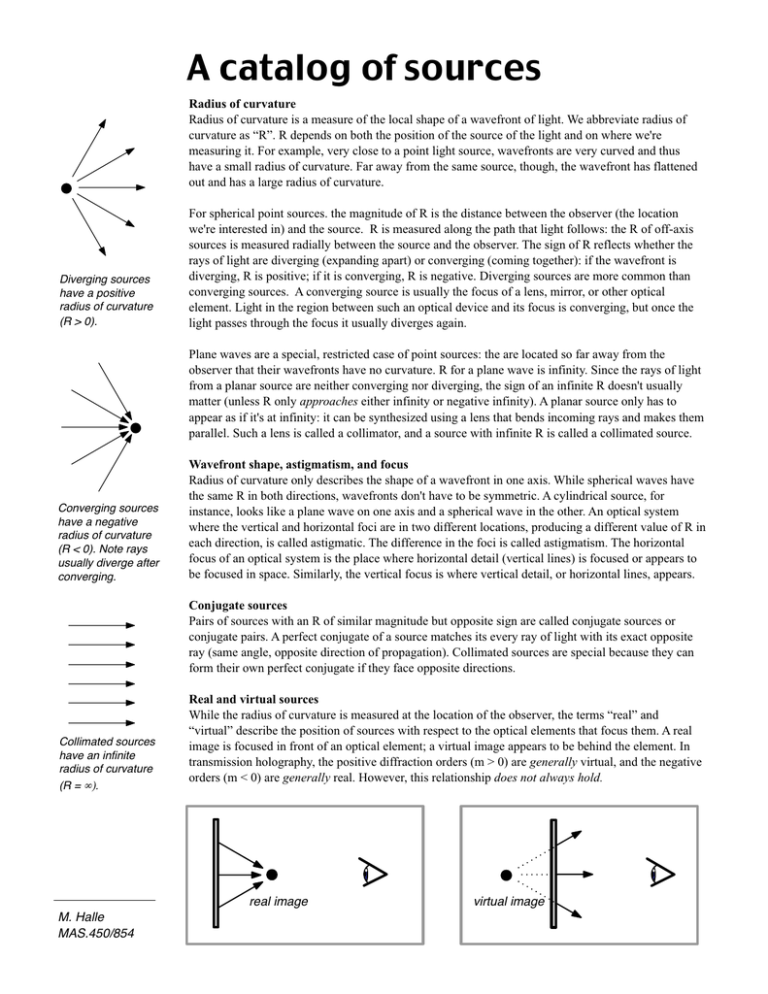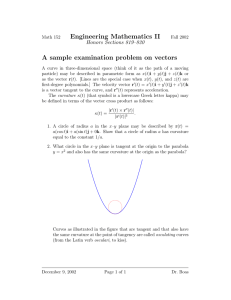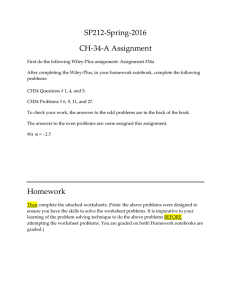A catalog of sources
advertisement

A catalog of sources Radius of curvature Radius of curvature is a measure of the local shape of a wavefront of light. We abbreviate radius of curvature as “R”. R depends on both the position of the source of the light and on where we're measuring it. For example, very close to a point light source, wavefronts are very curved and thus have a small radius of curvature. Far away from the same source, though, the wavefront has flattened out and has a large radius of curvature. Diverging sources have a positive radius of curvature (R > 0). For spherical point sources. the magnitude of R is the distance between the observer (the location we're interested in) and the source. R is measured along the path that light follows: the R of off-axis sources is measured radially between the source and the observer. The sign of R reflects whether the rays of light are diverging (expanding apart) or converging (coming together): if the wavefront is diverging, R is positive; if it is converging, R is negative. Diverging sources are more common than converging sources. A converging source is usually the focus of a lens, mirror, or other optical element. Light in the region between such an optical device and its focus is converging, but once the light passes through the focus it usually diverges again. Plane waves are a special, restricted case of point sources: the are located so far away from the observer that their wavefronts have no curvature. R for a plane wave is infinity. Since the rays of light from a planar source are neither converging nor diverging, the sign of an infinite R doesn't usually matter (unless R only approaches either infinity or negative infinity). A planar source only has to appear as if it's at infinity: it can be synthesized using a lens that bends incoming rays and makes them parallel. Such a lens is called a collimator, and a source with infinite R is called a collimated source. Converging sources have a negative radius of curvature (R < 0). Note rays usually diverge after converging. Wavefront shape, astigmatism, and focus Radius of curvature only describes the shape of a wavefront in one axis. While spherical waves have the same R in both directions, wavefronts don't have to be symmetric. A cylindrical source, for instance, looks like a plane wave on one axis and a spherical wave in the other. An optical system where the vertical and horizontal foci are in two different locations, producing a different value of R in each direction, is called astigmatic. The difference in the foci is called astigmatism. The horizontal focus of an optical system is the place where horizontal detail (vertical lines) is focused or appears to be focused in space. Similarly, the vertical focus is where vertical detail, or horizontal lines, appears. Conjugate sources Pairs of sources with an R of similar magnitude but opposite sign are called conjugate sources or conjugate pairs. A perfect conjugate of a source matches its every ray of light with its exact opposite ray (same angle, opposite direction of propagation). Collimated sources are special because they can form their own perfect conjugate if they face opposite directions. Collimated sources have an infinite radius of curvature (R = ∞). Real and virtual sources While the radius of curvature is measured at the location of the observer, the terms “real” and “virtual” describe the position of sources with respect to the optical elements that focus them. A real image is focused in front of an optical element; a virtual image appears to be behind the element. In transmission holography, the positive diffraction orders (m > 0) are generally virtual, and the negative orders (m < 0) are generally real. However, this relationship does not always hold. real image M. Halle MAS.450/854 virtual image


